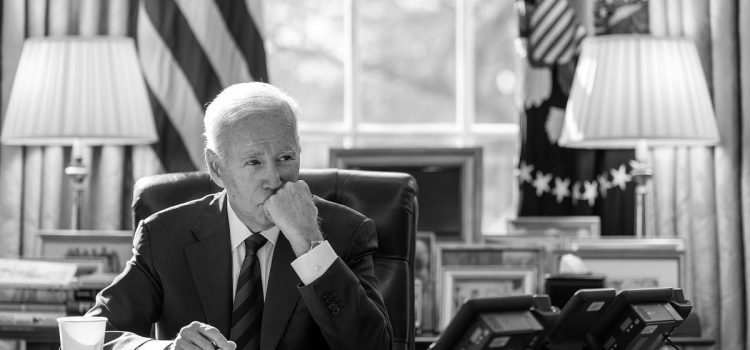
President Biden’s awful debate performance in June 2024 shocked millions of Americans. But, according to two journalists, that moment wasn’t a sudden decline—it was the inevitable result of years of carefully orchestrated deception.
Their explosive book Original Sin by Jake Tapper and Alex Thompson reveals how Biden’s inner circle, family, and Democratic allies allegedly worked together to hide his deteriorating condition from the public. Continue reading for a comprehensive overview of Original Sin: President Biden’s Decline, Its Cover-Up, and His Disastrous Choice to Run Again.
Overview of Original Sin by Jake Tapper and Alex Thompson
In June 2024, President Joe Biden’s debate performance against Donald Trump was so alarming that, within minutes, experts were saying he’d just lost the election. For many Americans, this was their first clear glimpse of a president who appeared confused, frail, and unable to articulate his thoughts. But, according to Jake Tapper and Alex Thompson, this moment of public revelation was predicated by years of systematic concealment. Original Sin by Jake Tapper and Alex Thompson presents their investigation into what they argue was a coordinated effort to hide Biden’s cognitive and physical deterioration from the American public, resulting in what they see as one of the most consequential political deceptions in recent American history.
Tapper brings decades of experience as a political journalist and CNN anchor, while Thompson covered the Biden administration for Axios. Based on interviews with more than 200 sources—primarily conducted after the 2024 election, when officials felt freer to speak candidly—their book contends that Biden’s decline began years before the debate, and that his inner circle, family, and the broader Democratic establishment worked to conceal this reality while pushing for his reelection. In this 2025 book, the authors argue that Biden’s decision to run again, coupled with the alleged cover-up of his diminished capacity, enabled Trump’s return to the presidency and undermined public trust in democratic institutions.
In this overview of Original Sin: President Biden’s Decline, Its Cover-Up, and His Disastrous Choice to Run Again, we explore Tapper and Thompson’s findings in three sections: first examining Biden’s condition and how it progressed, then investigating how this information was concealed, and finally tracing how the truth’s emergence led to political disaster for the Democratic Party.
The Decline
To understand how the alleged cover-up of President Biden’s decline developed, we’ll first examine what Tapper and Thompson claim was happening behind the scenes: Biden experienced significant cognitive and physical decline that began years before his presidency and worsened during his time in office, making him increasingly unable to perform the functions of the presidency. Tapper and Thompson conducted interviews with more than 200 sources, building the case that Biden’s decline had been carefully managed and concealed from public view. In this section, we’ll explore the timeline of his deterioration and the specific limitations this placed on his presidency.
The Timeline of Biden’s Decline
Tapper and Thompson contend that Biden’s decline began much earlier than most observers realized. The first signs of deterioration emerged after the death of his son Beau, from brain cancer in 2015. Insiders told the authors that Biden never fully recovered after Beau’s death. By 2017, Biden was struggling significantly. The authors cite recordings from that year of Biden speaking with his memoir ghostwriter, Mark Zwonitzer, in which Biden found it hard to remember things, experienced difficulty speaking, and often lost his train of thought. These recordings suggested to those who later heard them that Biden’s cognitive capacity was already failing him several years before he ran for president.
The problems became more apparent during the 2020 campaign, though they were largely hidden from public view. Tapper and Thompson report that campaign staff had to provide Biden with teleprompters for what were supposed to be spontaneous local news interviews, and his aides complained they couldn’t rely on him to stay on message due to his short attention span. The authors also describe campaign videos in which Biden was supposed to interact with voters over Zoom, but in the raw footage, Biden struggled to follow conversations and seemed confused. The material was so troubling that Democrats brought in a special editing team to salvage just a few minutes of usable footage from hours of recordings.
The authors argue that Biden’s condition continued to deteriorate during his presidency, and his decline became particularly pronounced in 2023. They report that sources close to Biden noticed that his struggles intensified during periods of extreme stress, particularly around his son Hunter’s legal troubles in 2023 and 2024. According to Tapper and Thompson, the stress of potentially losing another child—whether to overdose, suicide, or prison—contributed significantly to Biden’s mental and physical decline during this period.
Biden’s Cognitive Limitations
Tapper and Thompson paint a picture of a president who struggled with fundamental mental functions. They report Biden frequently couldn’t remember the names of top aides, sometimes calling National Security Advisor Jake Sullivan “Steve” and referring to his communications director simply as “press.” Biden also failed to remember people he’d known for decades, such as actor George Clooney, whom Biden didn’t initially recognize at a major fundraising event Clooney hosted for him. Only after an aide prompted him with Clooney’s name did Biden seem to remember who he was talking to. Similar incidents occurred with other longtime associates, unsettling those who witnessed them.
The authors report that Biden would frequently lose his train of thought during conversations, trailing off mid-sentence or abruptly changing topics. In meetings, Biden would sometimes appear to freeze up or stare blankly, leaving others in the room uncertain whether he was processing information or had lost focus. The authors describe instances when Biden needed cue cards not just for complex policy discussions but for basic social interactions, including prompts for what to say when asked what he was thankful for at Thanksgiving dinner. At times, Biden couldn’t remember basic facts about his own life, including when his son Beau had died, a loss that had been central to his identity and political narrative.
Biden’s Physical Decline
Tapper and Thompson also document Biden’s significant physical deterioration. His once-booming voice had become a whisper, and his confident stride had deteriorated into what sources described as a shuffle. This led staff to have him use shorter stairs to Air Force One and provide him with special black Hoka sneakers designed to help stabilize his gait. Despite these measures, the risk of falls remained a constant concern, and by late in his presidency, some staff members were reportedly considering whether Biden might need to use a wheelchair if he won a second term.
Biden’s declining energy also limited his schedule. The authors report that his effective working hours were restricted to roughly 10 a.m. to 4 p.m., with staff pushing as much of his schedule as possible to midday, when he was typically at his most alert. By late afternoon, sources told Tapper and Thompson, Biden would often appear drained and confused. Anything requiring urgent presidential attention outside these narrow hours became problematic.
The Impact on Presidential Functions
Tapper and Thompson argue that Biden’s limitations affected his ability to perform basic presidential duties beyond just public appearances. They suggest that his reduced capacity for sustained attention and complex reasoning impacted his ability to process information, make decisions, and provide leadership during critical moments. The authors present accounts from Cabinet secretaries who told them that by 2024, they didn’t believe Biden could handle the hypothetical 2 a.m. phone call needed during a national security crisis.
From early in Biden’s presidency, his mumbling delivery and need to have even internal discussions extensively scripted made Cabinet meetings awkward and uncomfortable. These meetings became increasingly rare, with one occurring in October 2023 and then not another until September 2024, after Biden had already dropped out of the race. According to Tapper and Thompson’s sources, this isolation was deliberately designed to limit who could observe Biden’s condition firsthand.
The Cover-Up
While Biden’s decline was apparent to many who saw it firsthand, Tapper and Thompson argue that a complex web of motivations and mechanisms kept this reality from reaching the public. According to the authors, Biden’s deterioration was systematically concealed through the coordinated efforts of his inner circle, family members, and broader Democratic establishment, all of whom had various reasons for maintaining the fiction that he remained fully capable of serving as president. In this section, we’ll examine the key players, the specific tactics they used to control information and access, and how they dealt with critics and potential whistleblowers.
The Inner Circle Decided to Hide Biden’s Condition
At the center of the alleged cover-up was Biden’s inner circle of advisors. Tapper and Thompson explain this group controlled access to the president and shaped the public narrative about his condition. They were united by their loyalty to Biden and their belief in two ideas: that Biden was uniquely capable of defeating Trump, and that any acknowledgment of his limitations would hand the presidency to someone they saw as an existential threat to democracy.
Because of these beliefs, the authors contend, Biden’s inner circle rationalized increasingly elaborate deceptions and accommodations. They managed his image through careful staging and presentation, had him professionally coached for major speeches, and used special lighting and sound equipment to optimize his appearance. They would sometimes film Biden in slow motion to blur how slowly he actually moved, and they experimented with different microphone setups to amplify his increasingly weak voice.
Tapper and Thompson describe how Biden’s family played crucial enforcement roles in this strategy. First Lady Jill Biden supported her husband’s decision to run for reelection while denying his cognitive and physical deterioration. She wielded influence through her chief of staff, who served as an enforcer of loyalty, silencing dissent and excommunicating anyone who raised questions about Biden’s fitness. The authors’ sources suggest that Jill Biden had become attached to the prominence and recognition that came with being First Lady—including multiple Vogue covers and extensive media attention—and was resistant to giving up that status.
Hunter Biden also played a key role in maintaining the protective narrative. The authors report that Hunter had a clear personal interest in keeping his father in office as potential protection from his own legal troubles. His recovery from addiction had become closely tied to his father’s political rise, making him invested in Biden’s continued presidency as a form of redemption for the problems he’d caused the family. According to Tapper and Thompson, Hunter would tell his father that Republican attacks were designed to make Hunter relapse into addiction or commit suicide, creating emotional pressure for Biden to continue fighting politically. Hunter helped push aside anyone who questioned his father’s fitness for continued service.
The Administration Controlled What Information Reached Biden
Tapper and Thompson document an elaborate system for controlling what information reached Biden and what information about Biden reached others. Biden’s advisors, particularly Mike Donilon, regularly presented him with misleadingly optimistic assessments of his political prospects. The authors report that polling data was consistently spun to suggest Biden was competitive in races where pollsters saw little chance of victory. This information management became so extreme that when a senior Democratic leader told Biden in July 2024 that his pollsters gave him only a 5% chance of winning, Biden responded with surprise, apparently unaware of how dire his situation had become.
The authors also report that Biden’s team prevented him from taking cognitive tests that might have provided objective evidence of his condition. Despite medical recommendations that people over 65 receive regular cognitive assessments, Biden’s personal physician refused to conduct such tests, arguing that he saw Biden daily and could monitor his condition informally. According to Tapper and Thompson, this decision was part of a broader strategy to avoid creating any official documentation of Biden’s limitations.
Biden’s Team Restricted Access to Him
Tapper and Thompson document how Biden’s team limited access to the president to prevent people from witnessing Biden’s condition firsthand. The authors describe how Cabinet secretaries and senior staff were briefed by the inner circle rather than being allowed to interact directly with Biden. When officials did have direct contact with Biden and expressed concerns about his condition, they were told he was fine and that their observations were mistaken or taken out of context.
Biden’s team also changed the nature of traditionally informal interactions. Teleprompters became essential even for small fundraising events with just 40 or 50 people—situations where politicians traditionally speak extemporaneously. Some donors became uncomfortable when Biden would simply read from prepared remarks and leave without the expected informal conversations. When concerns were raised about these changes, the authors report, they were dismissed as part of a new, more strategic approach to political communication.
Physical access to Biden was also limited through what the authors describe as “protective choreography.” Staff would walk beside him to catch him if he fell, guide him through events, and ensure he used shorter stairs and more stable pathways. While these measures were ostensibly for his safety, the authors argue they also served to limit spontaneous interactions that might reveal his condition.
Biden’s Team Attacked His Critics
Tapper and Thompson document how, when protective measures failed to prevent concerns about his fitness from emerging, Biden’s team attacked those who raised questions about his fitness. The authors describe this as a strategy to discredit critics and create disincentives for others to speak out. An example was the treatment of Special Counsel Robert Hur, whose investigation into Biden’s handling of classified documents included observations about his memory and cognitive state. Rather than addressing Hur’s findings, the White House portrayed him as a partisan actor, despite his careful approach to the investigation. This campaign was so effective that Hur was unable to find work for months after his report was released.
The authors also document how journalists who reported on Biden’s age or raised questions about his fitness were subjected to harsh criticism from the administration and its allies. Reporters were accused of advancing Republican talking points or promoting ageist stereotypes. The administration used the concept of “cheapfakes”—misleadingly edited videos—to dismiss any unflattering footage of Biden, even when the full context didn’t change the concerning nature of his behavior.
Democratic politicians who raised concerns faced similar treatment. The authors describe how Representative Dean Phillips of Minnesota, who attempted to challenge Biden in the primary partly due to concerns about Biden’s fitness, was systematically marginalized and kept off the ballots in various states. When other Democrats privately expressed concerns, they were told they were essentially helping Trump and undermining the party’s chances of preventing an authoritarian takeover.
Institutional Failures Enabled the Cover-Up
Tapper and Thompson argue that broader institutional failures let the cover-up continue. For example, the Democratic National Committee (DNC) changed primary rules in ways that benefited Biden, moving South Carolina to the first position on the primary calendar. While this was ostensibly done to elevate Black voters, the authors report that DNC officials admitted the main motivation was helping Biden, since South Carolina was one of his stronger states.
The authors suggest this institutional failure extended to Congress, where Democratic leadership remained silent about Biden’s condition. They argue that senators and representatives who had witnessed Biden’s decline firsthand chose party loyalty over their constitutional obligation to provide oversight of the executive branch. According to Tapper and Thompson, this combination of active deception by Biden’s inner circle and passive enablement by Democratic institutions created a system that kept the truth about Biden’s condition from reaching the public until it was too late to prevent the political disaster that followed.
The authors also describe how the media, despite some critical coverage, failed to investigate Biden’s condition thoroughly. This failure was partly due to access restrictions—Biden conducted fewer interviews and press conferences than any other recent president—but also due to a culture that made questioning his fitness seem inappropriate or partisan. Liberal media figures and Democratic politicians created an environment where even legitimate journalistic inquiry was discouraged.
The Consequences
Tapper and Thompson argue that despite the elaborate system designed to protect the president from scrutiny, the truth about Biden’s condition couldn’t be hidden indefinitely, and when it finally emerged, the consequences were catastrophic for the Democratic Party. The June 2024 debate exposed Biden’s decline in a way that couldn’t be explained away or controlled, starting a cascade of events that led to his withdrawal from the race and enabled Trump’s return to the presidency. In this section, we’ll trace the sequence of events from the debate through Biden’s withdrawal, examine the rushed Harris campaign that followed, and explore how the authors connect these events to Trump’s electoral victory.
The Debate Disaster
Tapper and Thompson recount that the June 27, 2024 debate was the moment when Biden’s carefully managed public image finally collapsed. The debate had been scheduled early in the campaign season partly because Biden’s team believed it would give them time to recover if things went poorly—a calculation that, according to the authors, revealed the team’s awareness of the risks involved. Tapper had firsthand experience of the debate, serving as co-moderator alongside CNN’s Dana Bash. Biden arrived late to the venue, having initially refused to do a walkthrough that every other candidate routinely performs, which the authors characterize as a sign of overconfidence despite his limitations.
The authors report that Biden’s performance was immediately recognized as disastrous by those watching behind the scenes. According to their account, this wasn’t a bad night or the result of a cold, as Biden’s team later claimed, but rather the natural result of putting someone with serious cognitive limitations in an uncontrolled, high-pressure situation. Tapper and Thompson contend the debate’s impact on Biden’s public perception was so severe because it contradicted the carefully constructed narrative about his fitness to run for reelection. Many viewers, including Democrats who’d been willing to give Biden the benefit of the doubt, could no longer rationalize what they were seeing and were shaken by his performance.
The Pressure Campaign
Tapper and Thompson document that Biden’s inner circle tried to control the damage. The campaign blamed external factors—Biden had a cold, he was tired from travel, it was just an off night. But pressure began building from multiple directions. First came the donors who had been kept at arm’s length. George Clooney, who had seen Biden’s decline at the fundraiser, felt that the debate confirmed what he had seen privately. Clooney wrote an op-ed in The New York Times calling for Biden to step down, arguing that he couldn’t effectively serve another term. Other major donors and Democratic figures began speaking out after Clooney broke the silence.
Next came pressure from Democratic members of Congress, who faced the reality that they might lose their own elections if Biden remained on the ticket. Tapper and Thompson explain that many legislators suddenly found themselves under pressure from constituents and colleagues and privately expressed their concerns to party leadership. Finally, senior Democratic leaders applied pressure. House Speaker Nancy Pelosi and Senate Majority Leader Chuck Schumer worked behind the scenes to convince Biden to step down—though they were careful to avoid public criticism that might appear disloyal or destructive to the party.
Biden’s Withdrawal
Tapper and Thompson write that two key factors ultimately convinced Biden to withdraw from the race. The first was Chuck Schumer’s revelation about the lack of Senate support: Schumer told Biden that in a meeting between Democratic senators and Biden’s top aides, only five out of 51 Democratic senators still supported Biden’s candidacy. This information shocked Biden, who took it to mean that his inner circle hadn’t been honest with him about the extent of the opposition within his own party.
The second decisive factor came from DNC manager Minyon Moore, who’d established a “What If Committee” to prepare for various contingencies, including the possibility that Biden’s nomination might be challenged. This committee had been monitoring delegate sentiment and warned Biden’s team that while he could still win the nomination, it would require an ugly floor fight. Tapper and Thompson report Biden’s decision to withdraw was driven by his realization that staying in the race would require a bitter battle that would split the party. He accepted that the political cost of remaining had become too high, though he continued to believe that he could have won the election if he’d stayed in the race.
The Harris Campaign’s Impossible Task
Tapper and Thompson argue that Kamala Harris’s elevation to the top of the ticket was doomed by the circumstances of her nomination. She inherited the baggage of the Biden administration, including voter concerns about the economy, immigration, and foreign policy—with only 107 days to define herself as a candidate and distance herself from an unpopular administration. She was also constrained by her loyalty to Biden and her role as his vice president. She couldn’t fully embrace Biden’s unpopular record, but she also couldn’t repudiate it without undermining her own position. This prevented Harris from effectively addressing voter concerns about the Biden administration’s performance.
The rushed nature of Harris’s campaign also prevented the kind of rigorous preparation that normally occurs during a full primary process. Tapper and Thompson suggest that Harris’s own limitations as a candidate, which had been apparent during her failed 2020 primary campaign, remained problematic. She continued to struggle with unscripted interactions and policy discussions, leading to a campaign that relied heavily on celebrity endorsements and scripted events rather than substantive policy debates.
The Ultimate Consequences
Tapper and Thompson conclude that Biden’s decision to run for reelection led to Trump’s victory. They argue that if Biden had announced after the 2022 midterms that he wouldn’t seek reelection, the Democratic Party could have held a proper primary. This could have produced a candidate who wasn’t burdened by the Biden administration’s unpopularity or the questions about age and fitness that had dominated the conversation. Democratic officials believed that Biden’s selfishness and his inner circle’s enablement had handed the presidency back to Trump.
Beyond the immediate electoral consequences, the authors argue that the alleged cover-up damaged the Democratic Party’s credibility and undermined public trust in democratic institutions. They suggest that the party’s insistence that Biden was fully capable of serving, followed by his obvious failure at the debate, created a broader crisis of confidence that extended beyond the presidential race. Tapper and Thompson conclude that the “original sin” of Biden’s decision to run again, combined with the systematic effort to conceal his limitations, represents not just a political miscalculation but a fundamental failure of democratic accountability that had far-reaching consequences for American politics and governance.






